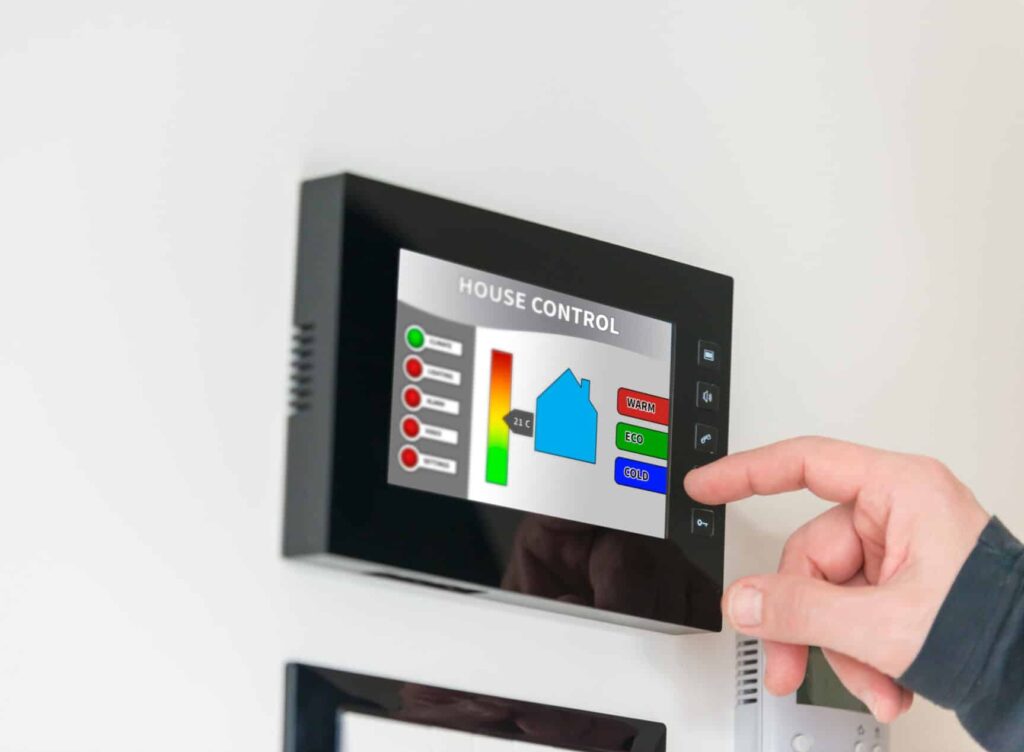
Exploring Voice-Controlled HVAC Systems
Ever wondered how you can control your home’s temperature without lifting a finger?
Voice-controlled HVAC systems are the latest innovation in home comfort technology. These systems allow you to manage your heating, ventilation, and air conditioning using simple voice commands. But how do they work, and what benefits do they offer?
Voice-controlled HVAC technology integrates your home’s HVAC system with smart home assistants like Amazon’s Alexa or Google Assistant. This setup involves a smart thermostat connected to your Wi-Fi network, which communicates with your HVAC system.
The key components include the smart thermostat, a compatible HVAC unit, and a smart assistant device. By using voice commands, you can adjust the temperature, switch between heating and cooling modes, and even create customized schedules without manually interacting with the thermostat.
One of the biggest benefits of voice-controlled HVAC systems is their convenience. Imagine adjusting your home’s temperature while cooking, cleaning, or even from the comfort of your bed, just by speaking a command.
These systems also enhance energy efficiency, potentially reducing your energy bills. Smart thermostats learn your preferences and adjust settings to optimize energy use. Enhanced comfort is another advantage, as you can fine-tune the temperature to suit your preferences at any time.
Benefits of Voice-Controlled HVAC Systems
Are you looking to simplify your home climate control while saving money and boosting comfort? Voice-controlled HVAC systems offer several benefits that make them a worthwhile investment for any homeowner.
Convenience and Ease of Use
The primary advantage of voice-controlled HVAC systems is their convenience. Managing your home’s temperature has never been easier. Instead of manually adjusting the thermostat, you can use voice commands to set the desired temperature, switch between heating and cooling modes, or turn the system off. This hands-free operation is especially useful when you’re busy with other tasks or simply want to adjust the temperature without leaving your couch.
Energy Efficiency and Cost Savings
Voice-controlled HVAC systems are designed to enhance energy efficiency, which can lead to significant cost savings. Smart thermostats learn your heating and cooling preferences over time and automatically adjust the settings to optimize energy use.
This means your system works more efficiently, reducing unnecessary energy consumption. Many smart thermostats also provide energy usage reports and tips for further improving efficiency, helping you save on your energy bills.
Enhanced Comfort and Customization
Another notable benefit is the enhanced comfort and customization these systems offer. With voice commands, you can quickly adjust the temperature to suit your preferences, ensuring your home is always at the optimal comfort level.
Additionally, you can create customized schedules for different times of the day or specific days of the week. For instance, you can program the system to lower the temperature at night for better sleep and increase it in the morning before you wake up.
How Voice-Controlled HVAC Systems Work
Curious about the inner workings of voice-controlled HVAC systems? These advanced systems seamlessly integrate with your smart home setup, offering effortless climate control through simple voice commands.
Integration with Smart Home Systems
Voice-controlled HVAC systems are designed to work harmoniously with your existing smart home ecosystem. They connect to your home Wi-Fi network, allowing you to control them via smart home assistants like Amazon Alexa and Google Assistant.
This integration means you can manage your HVAC settings using voice commands, smartphone apps, or even smart home hubs that control multiple devices simultaneously.
Use of Voice Commands and Smart Assistants
To operate a voice-controlled HVAC system, you’ll need a smart thermostat compatible with voice assistants. Once connected, you can use voice commands to perform various functions such as adjusting the temperature, switching modes, setting schedules, and even receiving weather updates.
For example, you might say, “Alexa, set the temperature to 72 degrees,” or “Hey Google, turn off the air conditioning.” These commands are processed by the smart assistant, which then communicates with the thermostat to adjust the HVAC system accordingly.
Key Components
The core components of a voice-controlled HVAC system include:
- Smart Thermostat: The central device that controls your HVAC system. Models like the Nest Learning Thermostat, Ecobee smart thermostat, and Honeywell Wi-Fi Smart Thermostats are popular choices.
- Smart Assistant Device: A device such as an Amazon Echo or Google Nest Hub that responds to voice commands.
- HVAC System: Your existing heating, ventilation, and air conditioning units, are controlled by the smart thermostat.
Popular Voice-Controlled HVAC Products
Interested in upgrading to a voice-controlled HVAC system but not sure where to start? Here are some of the most popular products that bring the convenience of voice control to your home.
- Honeywell Wi-Fi Smart Thermostats
Honeywell Wi-Fi Smart Thermostats are known for their reliability and ease of use. These thermostats connect seamlessly with Amazon Alexa, Google Assistant, and Apple HomeKit.
With features like programmable scheduling, energy-saving modes, and remote access through the Honeywell Home app, you can control your home’s temperature with just a few words. Honeywell’s thermostats also provide detailed energy reports, helping you track and reduce your energy usage.
- Ecobee SmartThermostat
The Ecobee SmartThermostat is another excellent choice for voice-controlled HVAC systems. This thermostat comes with built-in Amazon Alexa, allowing you to use voice commands directly without needing a separate smart assistant device.
The Ecobee SmartThermostat also features room sensors that detect occupancy and temperature, ensuring optimal comfort in every room. Its energy-saving capabilities and compatibility with various smart home platforms make it a versatile and efficient choice for any home.
- Nest Learning Thermostat
Google’s Nest Learning Thermostat is a pioneer in the smart thermostat market. It learns your schedule and preferences over time, automatically adjusting the temperature to save energy while keeping you comfortable.
The Nest Thermostat works with Google Assistant and Amazon Alexa, making it easy to control with your voice. Its sleek design and intuitive interface make it a favorite among homeowners looking for both style and functionality. Additionally, the Nest Thermostat provides detailed energy usage reports and tips for further savings.

How to Set Up a Voice-Controlled HVAC System
Ready to make your home smarter with a voice-controlled HVAC system? Setting up these systems involves several key steps, from ensuring compatibility to connecting with your smart home network.
Compatibility with Existing HVAC Systems
Before purchasing a smart thermostat, verify its compatibility with your current HVAC system. Most modern systems work with smart thermostats, but it’s essential to check specific requirements.
Review your HVAC system’s wiring and compare it with the smart thermostat’s compatibility guidelines. Some smart thermostats, like the Nest Learning Thermostat, offer a compatibility checker tool on their website to help you determine if it will work with your setup.
Installation Process and Considerations
Installing a voice-controlled HVAC system typically involves the following steps:
- Turn off power to your HVAC system to ensure safety.
- Remove the old thermostat and take note of the wiring configuration. Label the wires to match the terminals on your new smart thermostat.
- Install the new thermostat by connecting the labeled wires to the appropriate terminals. Mount the thermostat to the wall according to the manufacturer’s instructions.
- Power on your HVAC system and follow the setup instructions on the thermostat’s display.
Some homeowners prefer to hire a professional for installation, especially if the wiring is complex or if they are not comfortable with DIY electrical work.
Connecting to Wi-Fi and Smart Home Hubs
Once installed, the next step is connecting your smart thermostat to your home Wi-Fi network. This connection enables remote control and voice commands through smart assistants. Follow these steps:
- Download the thermostat’s app (e.g., Honeywell Home, Ecobee, or Nest).
- Create an account and follow the app’s prompts to connect the thermostat to your Wi-Fi network.
- Link the thermostat to your preferred smart assistant. For example, use the Alexa app or Google Home app to add the thermostat as a new device.
After completing these steps, you can control your HVAC system using voice commands, smartphone apps, or through smart home hubs.
Voice-Controlled HVAC in Carrollton, TX
Living in Carrollton, TX, means dealing with a range of temperatures throughout the year. A voice-controlled HVAC system can enhance your comfort and efficiency, making it easier to manage your home’s climate regardless of the season.
Local Climate Considerations
Carrollton experiences hot summers and mild winters, with temperatures often exceeding 90°F in the summer months. A voice-controlled HVAC system can help you stay cool during these peak temperatures. In winter, although the temperatures are generally mild, having a smart system ensures your home remains comfortable with minimal energy waste.
Popular Brands and Models in the Region
Residents of Carrollton favor several popular smart thermostat brands due to their reliability and advanced features. Among the top choices are:
- Honeywell Wi-Fi Smart Thermostats: Known for their user-friendly interface and compatibility with various HVAC systems.
- Ecobee SmartThermostat: Praised for its built-in Alexa functionality and room sensors that optimize temperature control.
- Nest Learning Thermostat: Valued for its learning capabilities and energy-saving features, making it a staple in many Carrollton homes.
Availability of Professional Installation Services
In Carrollton, numerous HVAC professionals offer installation services for smart thermostats. Hiring a professional ensures that your new system is installed correctly and efficiently, minimizing the risk of errors. Many local HVAC companies provide installation packages that include setup, configuration, and a tutorial on using your new voice-controlled system.
Additionally, some utility companies in Carrollton may offer incentives or rebates for installing energy-efficient smart thermostats. Check with your local providers to see if any programs are available to help offset the cost of your new system.
Advanced Features of Modern HVAC Systems
Today’s voice-controlled HVAC systems are packed with advanced features that go beyond simple temperature control. These innovations offer enhanced convenience, energy efficiency, and integration with other smart home devices.
Geofencing and Smart Scheduling
Geofencing is a technology that uses your smartphone’s location to automate your HVAC system’s settings. When you leave home, the system can automatically switch to an energy-saving mode, and when you return, it adjusts to your preferred comfort settings. This feature ensures that your home is always at the perfect temperature without wasting energy when you’re away.
Smart scheduling allows you to create detailed temperature schedules tailored to your daily routine. You can program different settings for weekdays and weekends or adjust the temperature based on specific times of the day. This customization helps optimize comfort and energy use.
Remote Control and Monitoring
With a voice-controlled HVAC system, you can control and monitor your home’s climate from anywhere using a smartphone app.
Whether you’re at work, on vacation, or simply in another room, you can adjust the temperature, change settings, and even receive alerts about your system’s performance. This remote access ensures you can always keep your home comfortable and efficient.
Integration with Other Smart Home Devices
Modern HVAC systems can integrate seamlessly with other smart home devices, creating a cohesive and automated home environment. For instance:
- Smart Lighting: Link your HVAC system with smart lighting to create customized scenes. For example, your lights can dim when the air conditioning turns on, creating a relaxing atmosphere.
- Security Systems: Integrate with smart security systems to enhance home safety. For instance, your HVAC system can respond to security alerts by adjusting temperature settings or activating fans to improve air circulation.
- Smart Speakers: Use devices like Amazon Echo or Google Home to control your HVAC system with voice commands.
Energy-Saving Modes and Insights
Advanced HVAC systems often come with energy-saving modes and detailed energy usage insights. These features help you monitor and reduce your energy consumption.
Many systems provide monthly energy reports, highlighting usage patterns and offering improvement tips. By understanding your energy use, you can make informed decisions to enhance efficiency and save money.
Improving Home Safety with Voice-Controlled HVAC
Did you know that a voice-controlled HVAC system can also enhance your home’s safety? These advanced systems integrate with various safety devices to provide a secure and healthy living environment.
Integration with CO2 Detectors
One of the significant safety features of smart HVAC systems is their ability to integrate with carbon dioxide (CO2) detectors. High levels of CO2 can indicate poor ventilation or malfunctioning HVAC equipment.
When connected to a CO2 detector, your smart thermostat can receive alerts if CO2 levels become unsafe. It can then automatically adjust the ventilation to improve air quality or notify you of the issue, ensuring a prompt response to potential hazards.
Automatic Shutdowns in Emergencies
In the event of an emergency, such as a fire or gas leak, having an HVAC system that can respond automatically can be crucial. Voice-controlled HVAC systems can be linked with smoke and gas detectors to initiate an automatic shutdown.
This feature helps to prevent the spread of smoke or gas throughout the house, mitigating damage and improving occupant safety. For example, if a smoke detector senses a fire, the HVAC system can shut down to avoid circulating smoke, while also triggering an alert for immediate evacuation.
Monitoring Indoor Air Quality
Maintaining good indoor air quality is essential for health, and smart HVAC systems excel in this area. They can monitor various air quality parameters, including humidity, particulate matter, and volatile organic compounds (VOCs).
When poor air quality is detected, the system can take actions such as increasing ventilation, activating air purifiers, or notifying you through the connected app.
Consistently monitoring and managing indoor air quality helps to create a healthier home environment, particularly for individuals with allergies or respiratory conditions.
DIY vs. Professional Installation
When setting up a voice-controlled HVAC system, you might wonder whether to tackle the installation yourself or hire a professional. Both options have their pros and cons, and understanding them can help you make an informed decision.
Pros and Cons of DIY Installation
Pros:
- Cost Savings: Doing it yourself can save you money on labor costs.
- Convenience: You can work on your schedule, without waiting for an appointment.
- Learning Experience: DIY installation provides a hands-on opportunity to learn more about your HVAC system and smart technology.
Cons:
- Complexity: HVAC systems can be complex, and improper installation can lead to inefficiency or damage.
- Time-Consuming: DIY installation might take longer, especially if you encounter unforeseen issues.
- Risk of Errors: Without professional expertise, there’s a higher chance of making mistakes that could affect the system’s performance.
Benefits of Hiring a Professional
Professional HVAC installation offers several advantages:
- Expertise: Professionals have the knowledge and experience to install the system correctly, ensuring optimal performance.
- Efficiency: A professional can complete the installation more quickly and efficiently.
- Warranty Protection: Many HVAC systems require professional installation to maintain the manufacturer’s warranty.
- Comprehensive Service: Professionals can also provide additional services like system checks, calibration, and initial setup of schedules and preferences.

FAQs
-
How do voice-controlled HVAC systems work?
Voice-controlled HVAC systems integrate smart thermostats with voice assistants like Amazon Alexa or Google Assistant. The thermostat connects to your home Wi-Fi, allowing you to control your HVAC system using voice commands or a smartphone app.
-
Are they compatible with all HVAC systems?
Not all smart thermostats are compatible with every HVAC system. It’s important to check the compatibility of your specific HVAC setup with the smart thermostat you choose. Many manufacturers provide compatibility checkers on their websites.
-
Can I control my HVAC system when I’m not home?
Yes, you can control your HVAC system remotely using the thermostat’s smartphone app. This feature allows you to adjust the temperature, set schedules, and monitor system performance from anywhere.
-
What are the main benefits of voice-controlled HVAC systems?
The primary benefits include convenience, energy efficiency, and enhanced comfort. These systems allow for hands-free control, optimize energy use to save money, and provide personalized comfort settings.
-
How much can I save on energy bills with a smart thermostat?
Savings vary, but studies show that smart thermostats can reduce heating and cooling costs by up to 10-15%. Features like learning algorithms, geofencing, and energy usage reports help optimize efficiency and lower energy bills.
Upgrading to a voice-controlled HVAC system offers numerous benefits that can transform your home environment. These systems provide unparalleled convenience, energy efficiency, and enhanced comfort, all while integrating seamlessly with other smart home devices.






